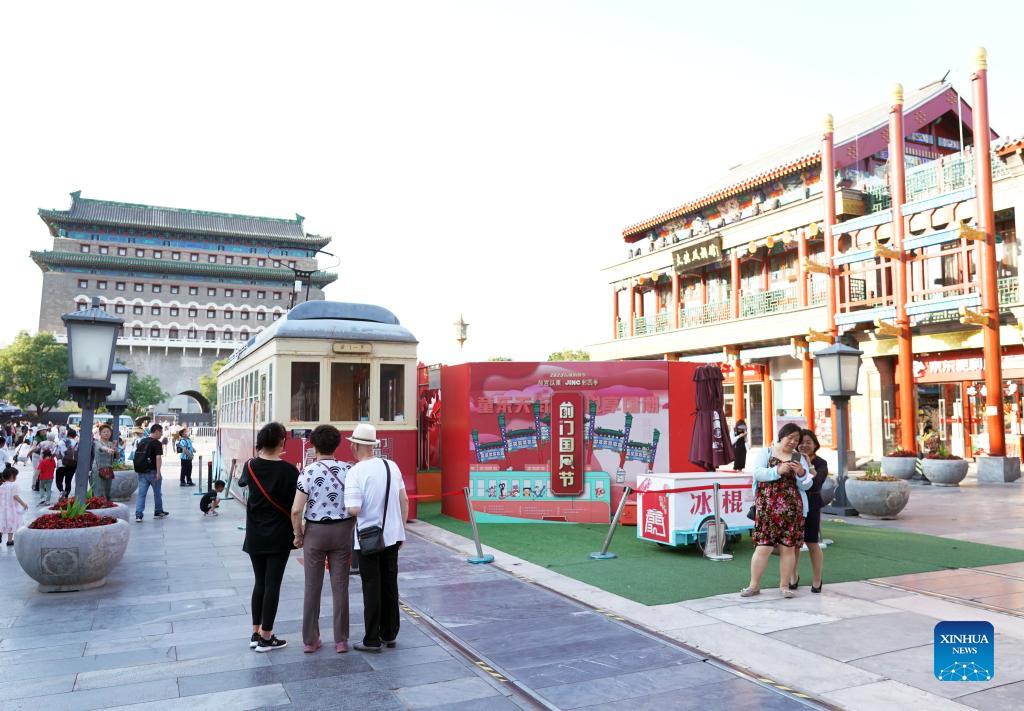
People visit Qianmen Street in central Beijing, capital of China, June 6, 2023. First created in the Yuan Dynasty (1271-1368), the Beijing Central Axis, or Zhongzhouxian, stretches 7.8 kilometers between the Yongding Gate (Yongdingmen) in the south of the city and the Drum Tower and Bell Tower in the north. Most of the major old-city buildings of Beijing sit along this axis. Fourteen historical places along the axis, including Qianmen, the Forbidden City, Jingshan Park, the Drum and Bell Towers, and Tian'anmen Square have been identified as the key heritage sites. (Xinhua/Ren Chao)
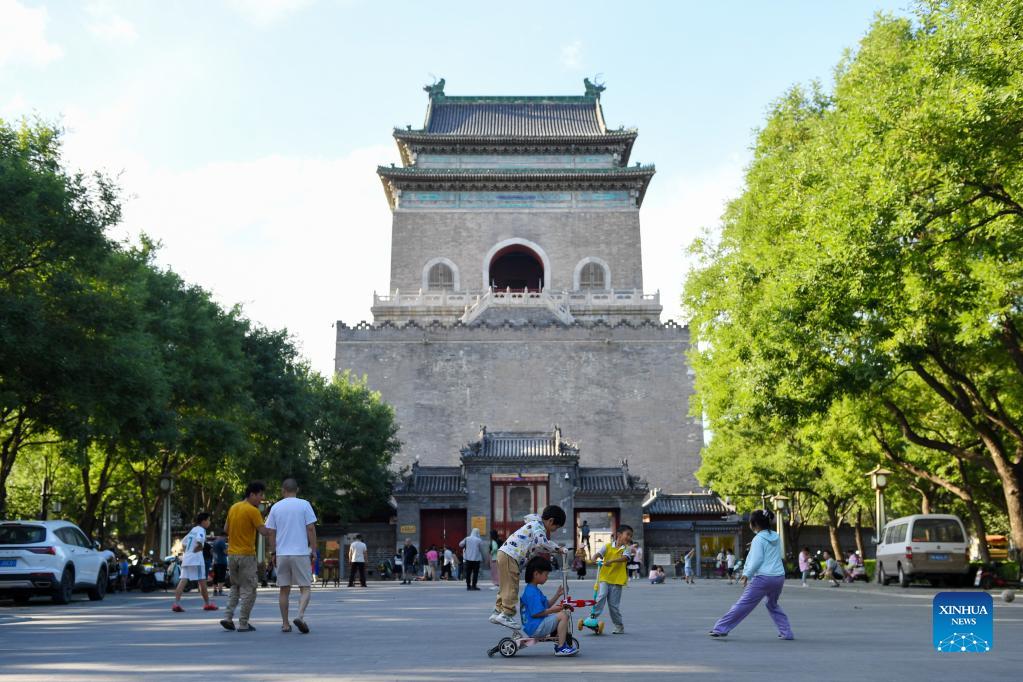
Children have fun at a square between the Drum Tower and the Bell Tower in Beijing, capital of China, June 9, 2023. First created in the Yuan Dynasty (1271-1368), the Beijing Central Axis, or Zhongzhouxian, stretches 7.8 kilometers between the Yongding Gate (Yongdingmen) in the south of the city and the Drum Tower and Bell Tower in the north. Most of the major old-city buildings of Beijing sit along this axis. Fourteen historical places along the axis, including Qianmen, the Forbidden City, Jingshan Park, the Drum and Bell Towers, and Tian'anmen Square have been identified as the key heritage sites. (Xinhua/Ju Huanzong)

People take photos in Jingshan Park near the Forbidden City in Beijing, capital of China, June 8, 2023. First created in the Yuan Dynasty (1271-1368), the Beijing Central Axis, or Zhongzhouxian, stretches 7.8 kilometers between the Yongding Gate (Yongdingmen) in the south of the city and the Drum Tower and Bell Tower in the north. Most of the major old-city buildings of Beijing sit along this axis. Fourteen historical places along the axis, including Qianmen, the Forbidden City, Jingshan Park, the Drum and Bell Towers, and Tian'anmen Square have been identified as the key heritage sites. (Xinhua/Ju Huanzong)
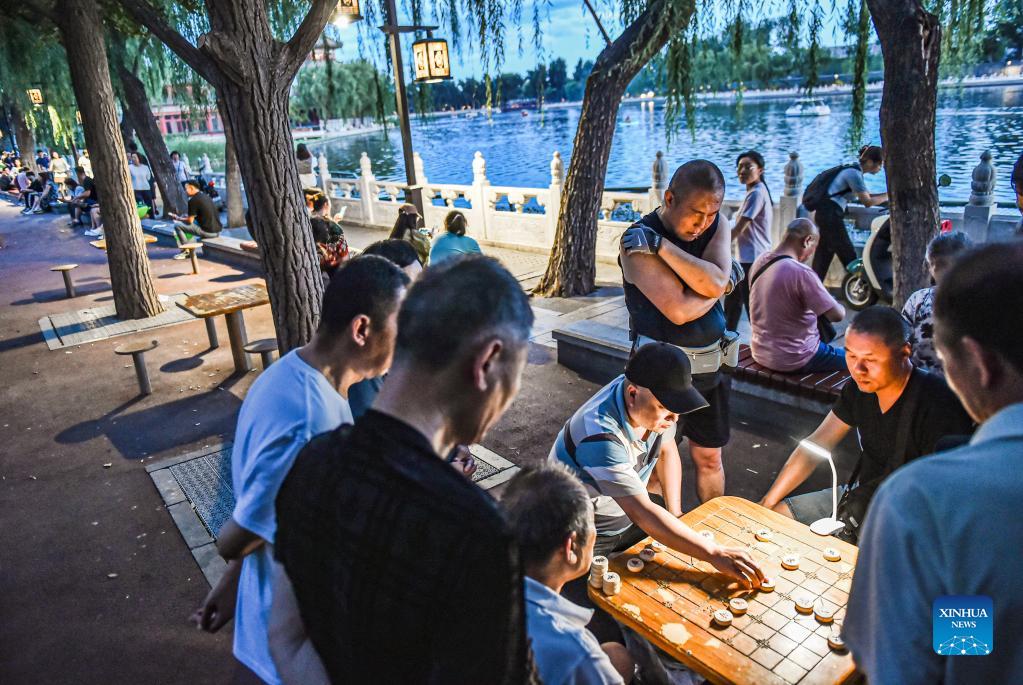
People play Xiangqi, or Chinese chess, by Shichahai Lake in central Beijing, capital of China, June 10, 2023. First created in the Yuan Dynasty (1271-1368), the Beijing Central Axis, or Zhongzhouxian, stretches 7.8 kilometers between the Yongding Gate (Yongdingmen) in the south of the city and the Drum Tower and Bell Tower in the north. Most of the major old-city buildings of Beijing sit along this axis. Fourteen historical places along the axis, including Qianmen, the Forbidden City, Jingshan Park, the Drum and Bell Towers, and Tian'anmen Square have been identified as the key heritage sites. (Xinhua/Chen Zhonghao)

Locals enjoy tea at their courtyard in a hutong near the Drum Tower and Bell Tower in Beijing, capital of China, June 12, 2023. First created in the Yuan Dynasty (1271-1368), the Beijing Central Axis, or Zhongzhouxian, stretches 7.8 kilometers between the Yongding Gate (Yongdingmen) in the south of the city and the Drum Tower and Bell Tower in the north. Most of the major old-city buildings of Beijing sit along this axis. Fourteen historical places along the axis, including Qianmen, the Forbidden City, Jingshan Park, the Drum and Bell Towers, and Tian'anmen Square have been identified as the key heritage sites. (Xinhua/Chen Zhonghao)

People have fun in front of the Yongding Gate in south Beijing, capital of China, June 6, 2023. First created in the Yuan Dynasty (1271-1368), the Beijing Central Axis, or Zhongzhouxian, stretches 7.8 kilometers between the Yongding Gate (Yongdingmen) in the south of the city and the Drum Tower and Bell Tower in the north. Most of the major old-city buildings of Beijing sit along this axis. Fourteen historical places along the axis, including Qianmen, the Forbidden City, Jingshan Park, the Drum and Bell Towers, and Tian'anmen Square have been identified as the key heritage sites. (Xinhua/Ju Huanzong)
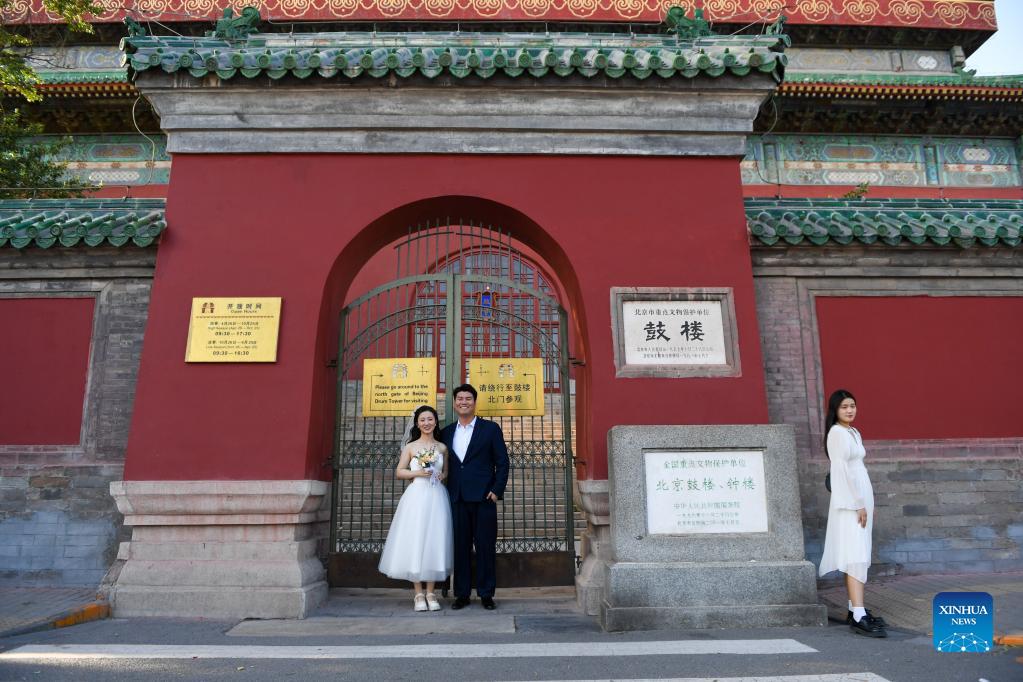
People pose for photos in front of the Drum Tower in Beijing, capital of China, June 9, 2023. First created in the Yuan Dynasty (1271-1368), the Beijing Central Axis, or Zhongzhouxian, stretches 7.8 kilometers between the Yongding Gate (Yongdingmen) in the south of the city and the Drum Tower and Bell Tower in the north. Most of the major old-city buildings of Beijing sit along this axis. Fourteen historical places along the axis, including Qianmen, the Forbidden City, Jingshan Park, the Drum and Bell Towers, and Tian'anmen Square have been identified as the key heritage sites. (Xinhua/Ju Huanzong)

A man takes photos of a turret of the Forbidden City in Beijing, capital of China, June 6, 2023. First created in the Yuan Dynasty (1271-1368), the Beijing Central Axis, or Zhongzhouxian, stretches 7.8 kilometers between the Yongding Gate (Yongdingmen) in the south of the city and the Drum Tower and Bell Tower in the north. Most of the major old-city buildings of Beijing sit along this axis. Fourteen historical places along the axis, including Qianmen, the Forbidden City, Jingshan Park, the Drum and Bell Towers, and Tian'anmen Square have been identified as the key heritage sites. (Xinhua/Zhang Chenlin)
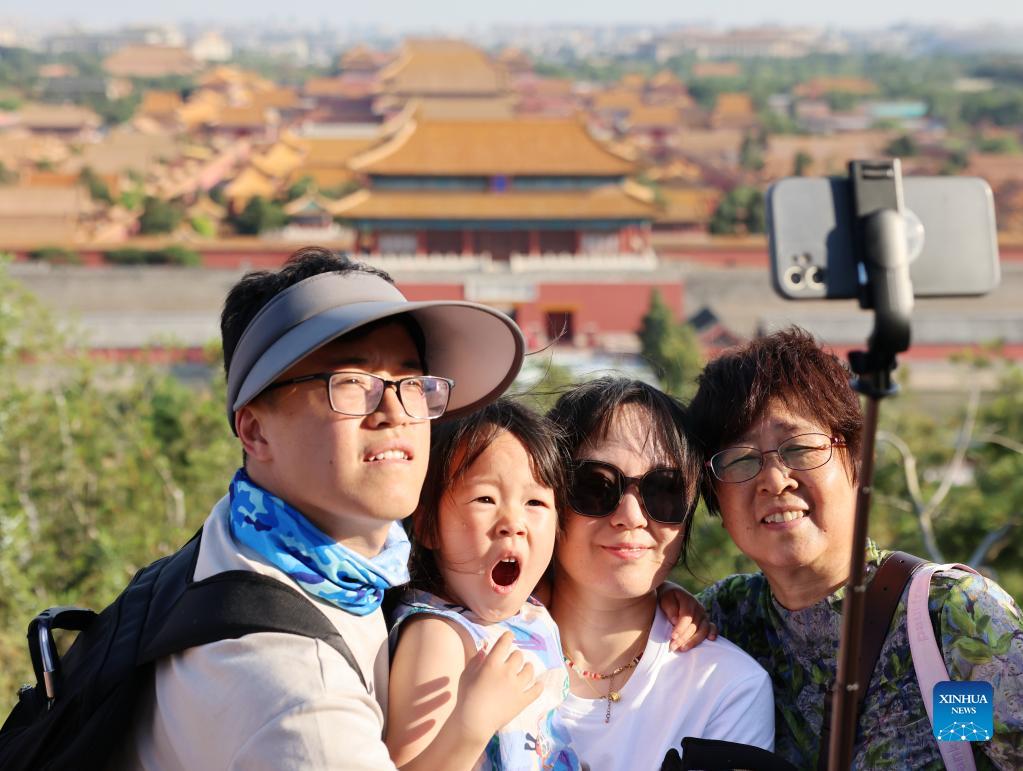
People take selfies in Jingshan Park near the Forbidden City in Beijing, capital of China, June 6, 2023. First created in the Yuan Dynasty (1271-1368), the Beijing Central Axis, or Zhongzhouxian, stretches 7.8 kilometers between the Yongding Gate (Yongdingmen) in the south of the city and the Drum Tower and Bell Tower in the north. Most of the major old-city buildings of Beijing sit along this axis. Fourteen historical places along the axis, including Qianmen, the Forbidden City, Jingshan Park, the Drum and Bell Towers, and Tian'anmen Square have been identified as the key heritage sites. (Xinhua/Zhang Chenlin)

People visit the Tian'anmen Square in Beijing, capital of China, June 8, 2023. First created in the Yuan Dynasty (1271-1368), the Beijing Central Axis, or Zhongzhouxian, stretches 7.8 kilometers between the Yongding Gate (Yongdingmen) in the south of the city and the Drum Tower and Bell Tower in the north. Most of the major old-city buildings of Beijing sit along this axis. Fourteen historical places along the axis, including Qianmen, the Forbidden City, Jingshan Park, the Drum and Bell Towers, and Tian'anmen Square have been identified as the key heritage sites. (Xinhua/Ren Chao)

Visitors are seen on the Wanning Bridge, which was built in Yuan Dynasty (1271-1368) in 1285, in Beijing, capital of China, June 9, 2023. First created in the Yuan Dynasty (1271-1368), the Beijing Central Axis, or Zhongzhouxian, stretches 7.8 kilometers between the Yongding Gate (Yongdingmen) in the south of the city and the Drum Tower and Bell Tower in the north. Most of the major old-city buildings of Beijing sit along this axis. Fourteen historical places along the axis, including Qianmen, the Forbidden City, Jingshan Park, the Drum and Bell Towers, and Tian'anmen Square have been identified as the key heritage sites. (Xinhua/Ju Huanzong)

This photo taken with a mobile phone shows people jogging in Tiantan (Temple of Heaven) Park in Beijing, capital of China, June 3, 2023. First created in the Yuan Dynasty (1271-1368), the Beijing Central Axis, or Zhongzhouxian, stretches 7.8 kilometers between the Yongding Gate (Yongdingmen) in the south of the city and the Drum Tower and Bell Tower in the north. Most of the major old-city buildings of Beijing sit along this axis. Fourteen historical places along the axis, including Qianmen, the Forbidden City, Jingshan Park, the Drum and Bell Towers, and Tian'anmen Square have been identified as the key heritage sites. (Xinhua/Ju Huanzong)

Tourists visit the Shichahai Lake Park in central Beijing, capital of China, June 9, 2023. First created in the Yuan Dynasty (1271-1368), the Beijing Central Axis, or Zhongzhouxian, stretches 7.8 kilometers between the Yongding Gate (Yongdingmen) in the south of the city and the Drum Tower and Bell Tower in the north. Most of the major old-city buildings of Beijing sit along this axis. Fourteen historical places along the axis, including Qianmen, the Forbidden City, Jingshan Park, the Drum and Bell Towers, and Tian'anmen Square have been identified as the key heritage sites. (Xinhua/Ju Huanzong)

Visitors take a rickshaw ride passing the Wanning Bridge built in Yuan Dynasty (1271-1368) in Beijing, capital of China, June 11, 2023. First created in the Yuan Dynasty (1271-1368), the Beijing Central Axis, or Zhongzhouxian, stretches 7.8 kilometers between the Yongding Gate (Yongdingmen) in the south of the city and the Drum Tower and Bell Tower in the north. Most of the major old-city buildings of Beijing sit along this axis. Fourteen historical places along the axis, including Qianmen, the Forbidden City, Jingshan Park, the Drum and Bell Towers, and Tian'anmen Square have been identified as the key heritage sites. (Xinhua/Chen Zhonghao)
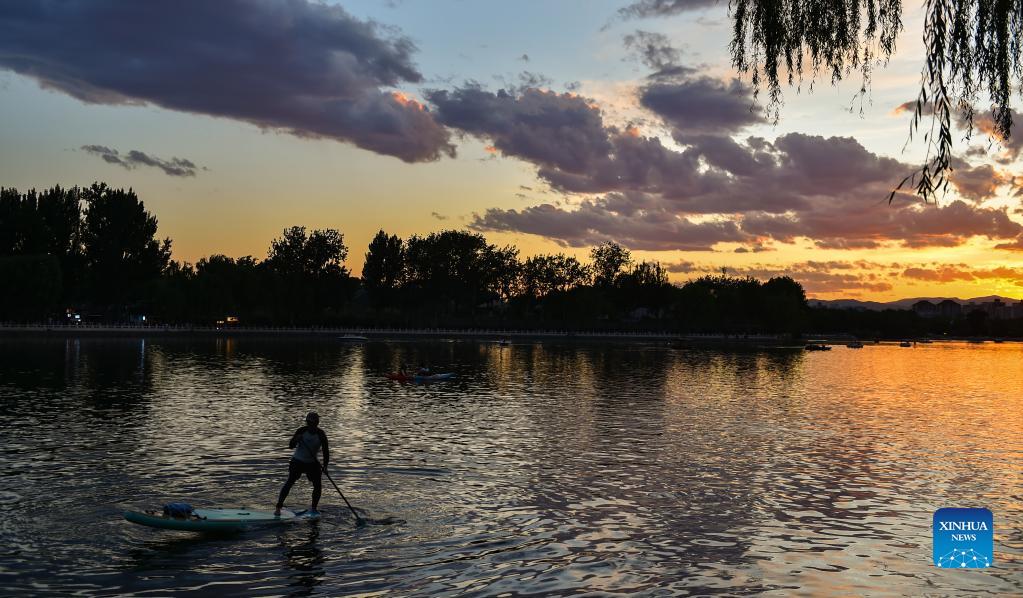
This photo taken on June 10, 2023 shows Shichahai Lake at sunset in central Beijing, capital of China. First created in the Yuan Dynasty (1271-1368), the Beijing Central Axis, or Zhongzhouxian, stretches 7.8 kilometers between the Yongding Gate (Yongdingmen) in the south of the city and the Drum Tower and Bell Tower in the north. Most of the major old-city buildings of Beijing sit along this axis. Fourteen historical places along the axis, including Qianmen, the Forbidden City, Jingshan Park, the Drum and Bell Towers, and Tian'anmen Square have been identified as the key heritage sites. (Xinhua/Chen Zhonghao)

People visit Tiantan (Temple of Heaven) Park in Beijing, capital of China, April 29, 2023. First created in the Yuan Dynasty (1271-1368), the Beijing Central Axis, or Zhongzhouxian, stretches 7.8 kilometers between the Yongding Gate (Yongdingmen) in the south of the city and the Drum Tower and Bell Tower in the north. Most of the major old-city buildings of Beijing sit along this axis. Fourteen historical places along the axis, including Qianmen, the Forbidden City, Jingshan Park, the Drum and Bell Towers, and Tian'anmen Square have been identified as the key heritage sites. (Xinhua/Ju Huanzong)

A young girl has fun with some bronze statues in Qianmen Street in central Beijing, capital of China, June 11, 2023. First created in the Yuan Dynasty (1271-1368), the Beijing Central Axis, or Zhongzhouxian, stretches 7.8 kilometers between the Yongding Gate (Yongdingmen) in the south of the city and the Drum Tower and Bell Tower in the north. Most of the major old-city buildings of Beijing sit along this axis. Fourteen historical places along the axis, including Qianmen, the Forbidden City, Jingshan Park, the Drum and Bell Towers, and Tian'anmen Square have been identified as the key heritage sites. (Xinhua/Zhang Chenlin)
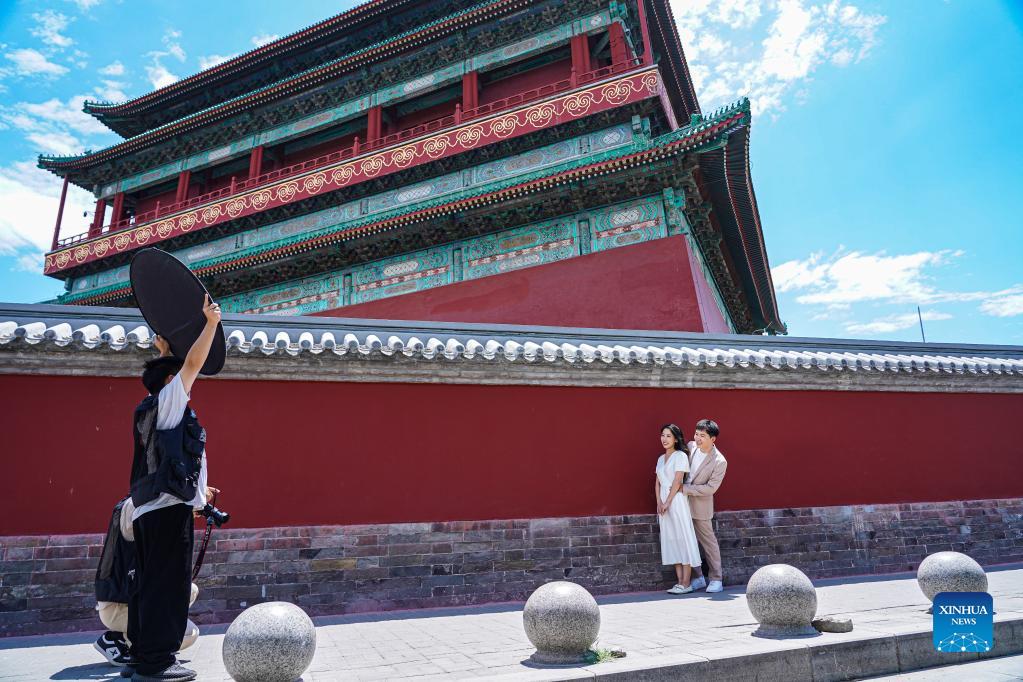
People pose for photos by the Drum Tower in Beijing, capital of China, June 11, 2023. First created in the Yuan Dynasty (1271-1368), the Beijing Central Axis, or Zhongzhouxian, stretches 7.8 kilometers between the Yongding Gate (Yongdingmen) in the south of the city and the Drum Tower and Bell Tower in the north. Most of the major old-city buildings of Beijing sit along this axis. Fourteen historical places along the axis, including Qianmen, the Forbidden City, Jingshan Park, the Drum and Bell Towers, and Tian'anmen Square have been identified as the key heritage sites. (Xinhua/Chen Zhonghao)

People walk through a gate in the Forbidden City in Beijing, capital of China, March 27, 2023. First created in the Yuan Dynasty (1271-1368), the Beijing Central Axis, or Zhongzhouxian, stretches 7.8 kilometers between the Yongding Gate (Yongdingmen) in the south of the city and the Drum Tower and Bell Tower in the north. Most of the major old-city buildings of Beijing sit along this axis. Fourteen historical places along the axis, including Qianmen, the Forbidden City, Jingshan Park, the Drum and Bell Towers, and Tian'anmen Square have been identified as the key heritage sites. (Xinhua/Chen Zhonghao)

People walk past a bookstore established in a historic building on Di'anmenwai Street in Beijing, capital of China, June 11, 2023. First created in the Yuan Dynasty (1271-1368), the Beijing Central Axis, or Zhongzhouxian, stretches 7.8 kilometers between the Yongding Gate (Yongdingmen) in the south of the city and the Drum Tower and Bell Tower in the north. Most of the major old-city buildings of Beijing sit along this axis. Fourteen historical places along the axis, including Qianmen, the Forbidden City, Jingshan Park, the Drum and Bell Towers, and Tian'anmen Square have been identified as the key heritage sites. (Xinhua/Chen Zhonghao)

People look over the terrace of a coffee shop near Shichahai Lake in central Beijing, capital of China, June 10, 2023. First created in the Yuan Dynasty (1271-1368), the Beijing Central Axis, or Zhongzhouxian, stretches 7.8 kilometers between the Yongding Gate (Yongdingmen) in the south of the city and the Drum Tower and Bell Tower in the north. Most of the major old-city buildings of Beijing sit along this axis. Fourteen historical places along the axis, including Qianmen, the Forbidden City, Jingshan Park, the Drum and Bell Towers, and Tian'anmen Square have been identified as the key heritage sites. (Xinhua/Chen Zhonghao)

A boy has fun in the Yongdingmen Park in south Beijing, capital of China, June 6, 2023. First created in the Yuan Dynasty (1271-1368), the Beijing Central Axis, or Zhongzhouxian, stretches 7.8 kilometers between the Yongding Gate (Yongdingmen) in the south of the city and the Drum Tower and Bell Tower in the north. Most of the major old-city buildings of Beijing sit along this axis. Fourteen historical places along the axis, including Qianmen, the Forbidden City, Jingshan Park, the Drum and Bell Towers, and Tian'anmen Square have been identified as the key heritage sites. (Xinhua/Ju Huanzong)

Tourists visit a commercial street near Shichahai Lake in central Beijing, capital of China, June 9, 2023. First created in the Yuan Dynasty (1271-1368), the Beijing Central Axis, or Zhongzhouxian, stretches 7.8 kilometers between the Yongding Gate (Yongdingmen) in the south of the city and the Drum Tower and Bell Tower in the north. Most of the major old-city buildings of Beijing sit along this axis. Fourteen historical places along the axis, including Qianmen, the Forbidden City, Jingshan Park, the Drum and Bell Towers, and Tian'anmen Square have been identified as the key heritage sites. (Xinhua/Ju Huanzong)
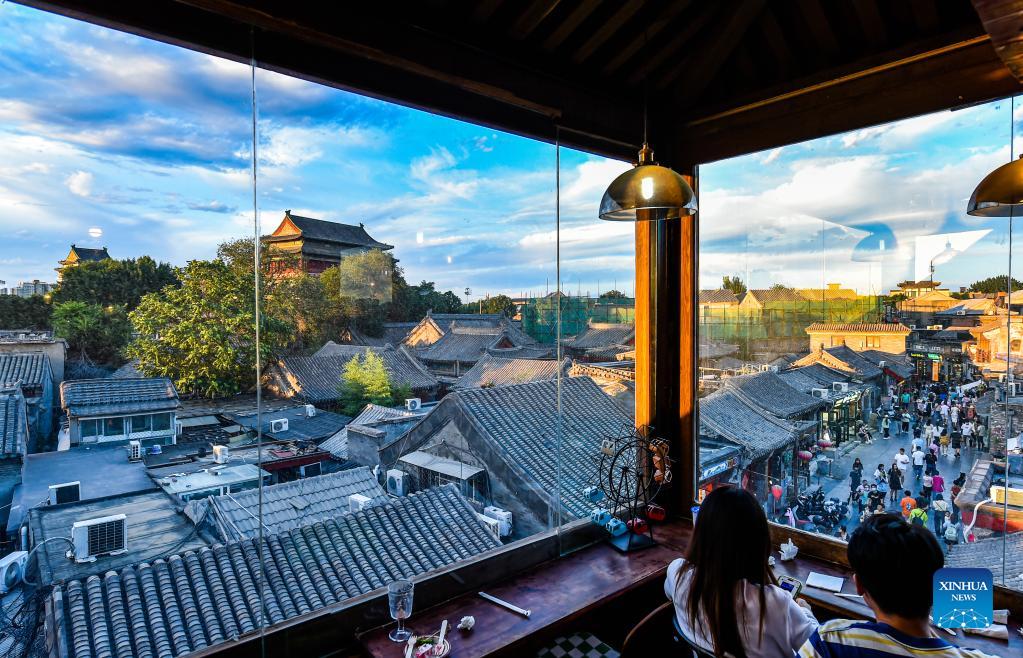
People look out of the windows of a coffee shop near Shichahai Lake in central Beijing, capital of China, June 10, 2023. First created in the Yuan Dynasty (1271-1368), the Beijing Central Axis, or Zhongzhouxian, stretches 7.8 kilometers between the Yongding Gate (Yongdingmen) in the south of the city and the Drum Tower and Bell Tower in the north. Most of the major old-city buildings of Beijing sit along this axis. Fourteen historical places along the axis, including Qianmen, the Forbidden City, Jingshan Park, the Drum and Bell Towers, and Tian'anmen Square have been identified as the key heritage sites. (Xinhua/Chen Zhonghao)
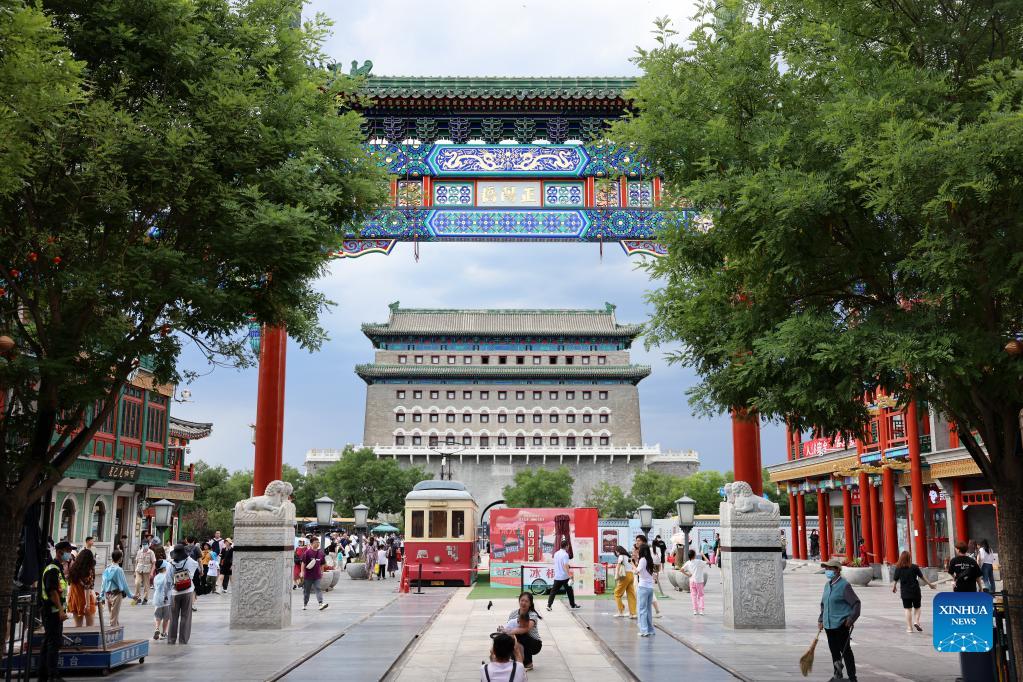
People visit Qianmen Street in central Beijing, capital of China, June 11, 2023. First created in the Yuan Dynasty (1271-1368), the Beijing Central Axis, or Zhongzhouxian, stretches 7.8 kilometers between the Yongding Gate (Yongdingmen) in the south of the city and the Drum Tower and Bell Tower in the north. Most of the major old-city buildings of Beijing sit along this axis. Fourteen historical places along the axis, including Qianmen, the Forbidden City, Jingshan Park, the Drum and Bell Towers, and Tian'anmen Square have been identified as the key heritage sites. (Xinhua/Zhang Chenlin)



